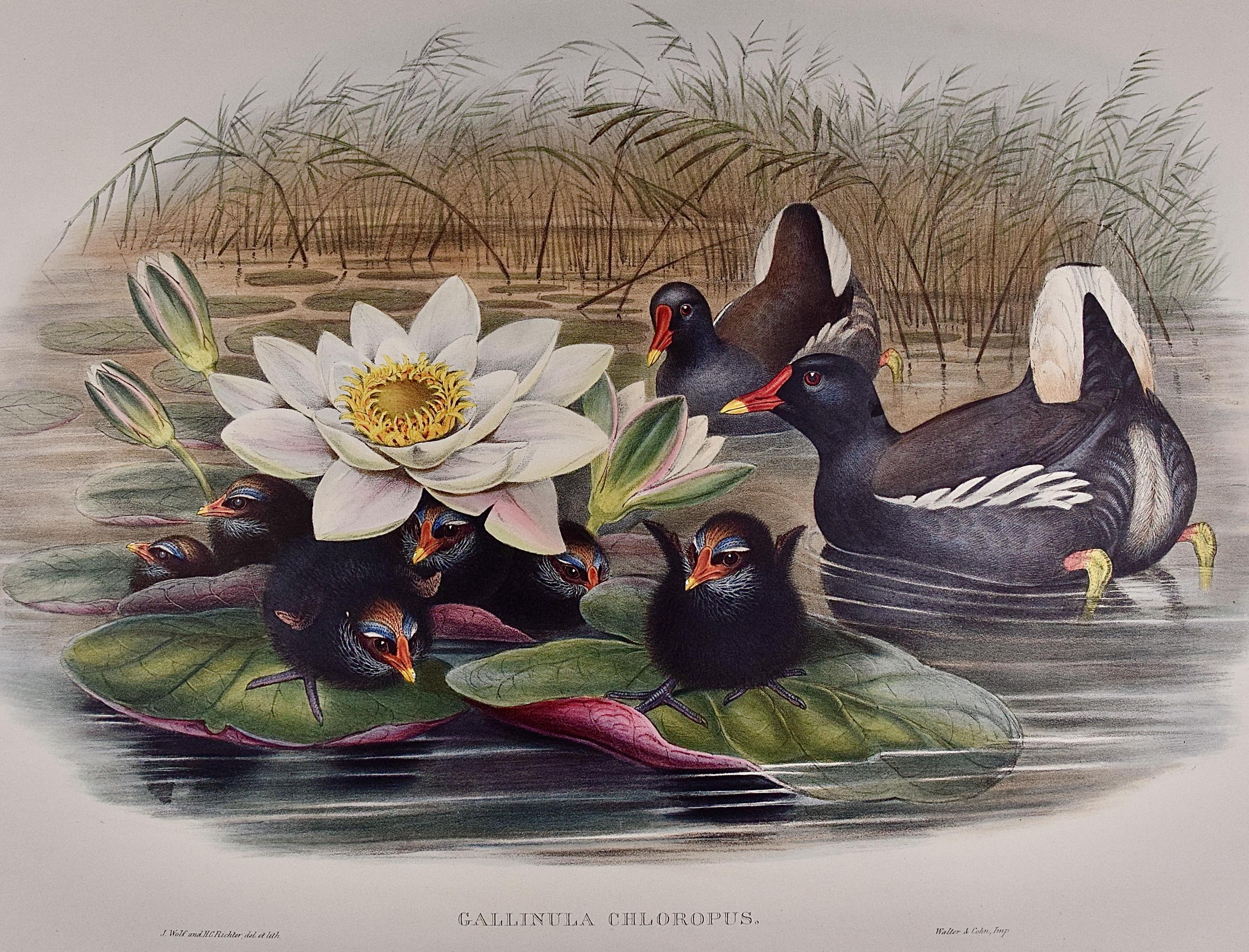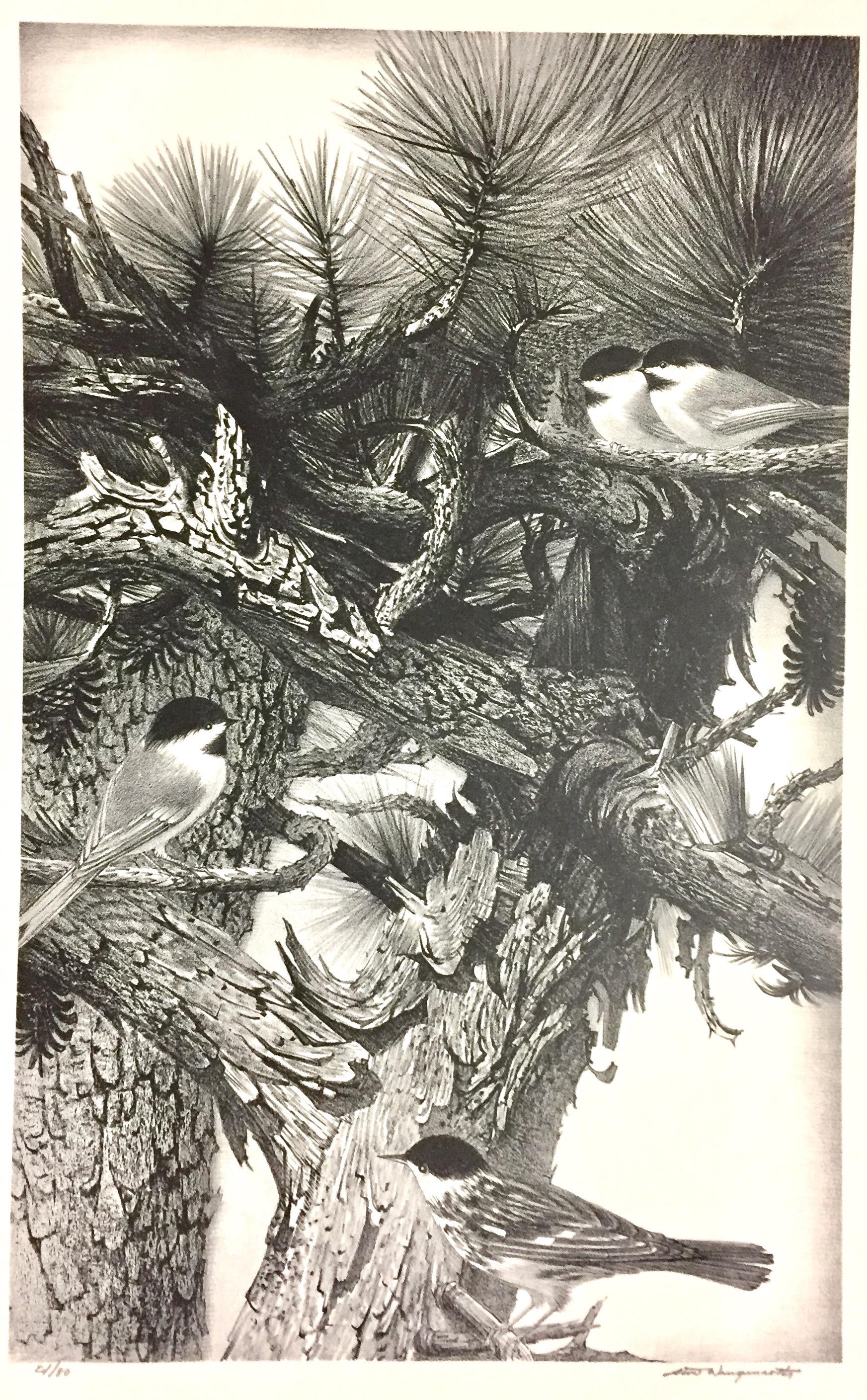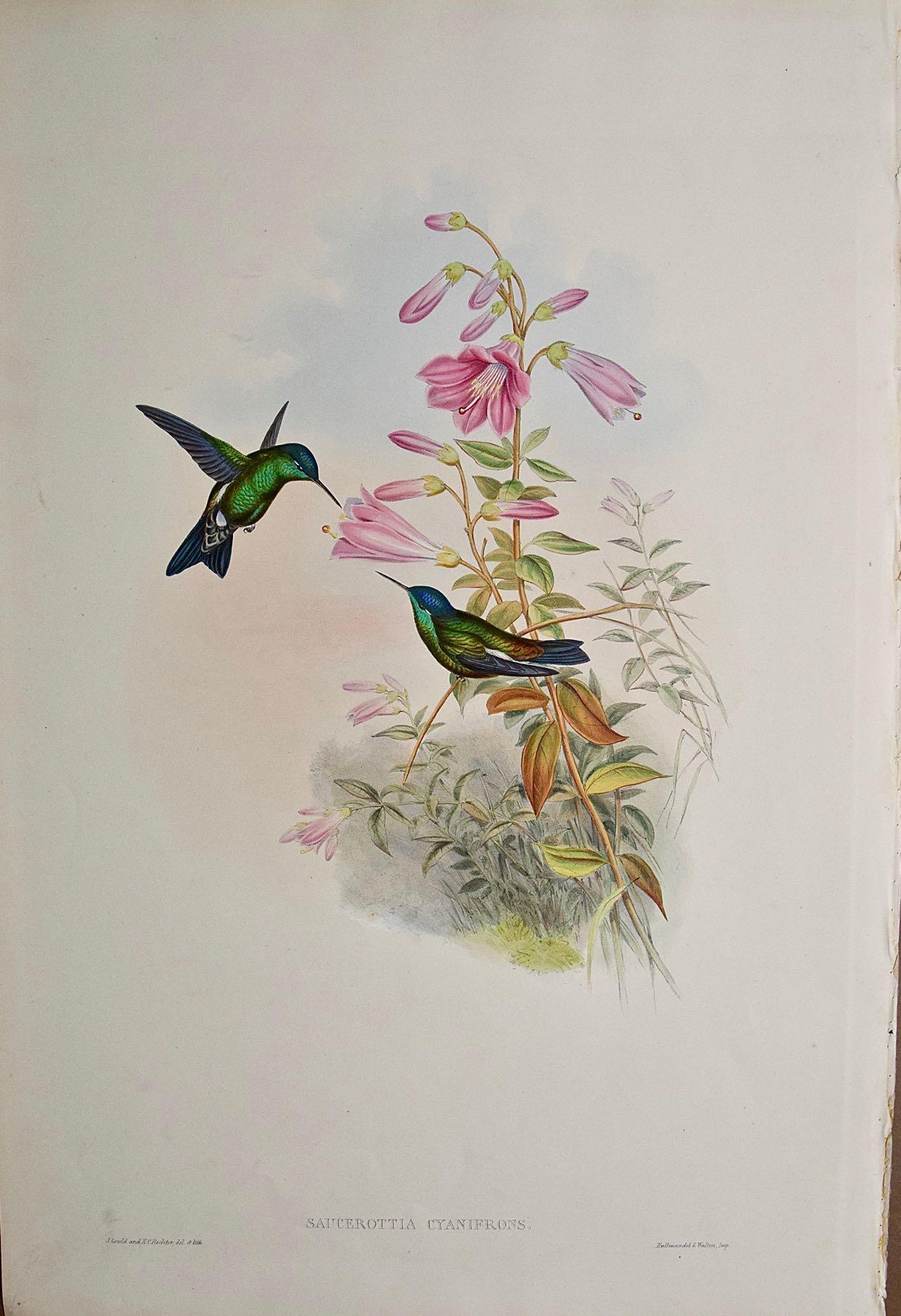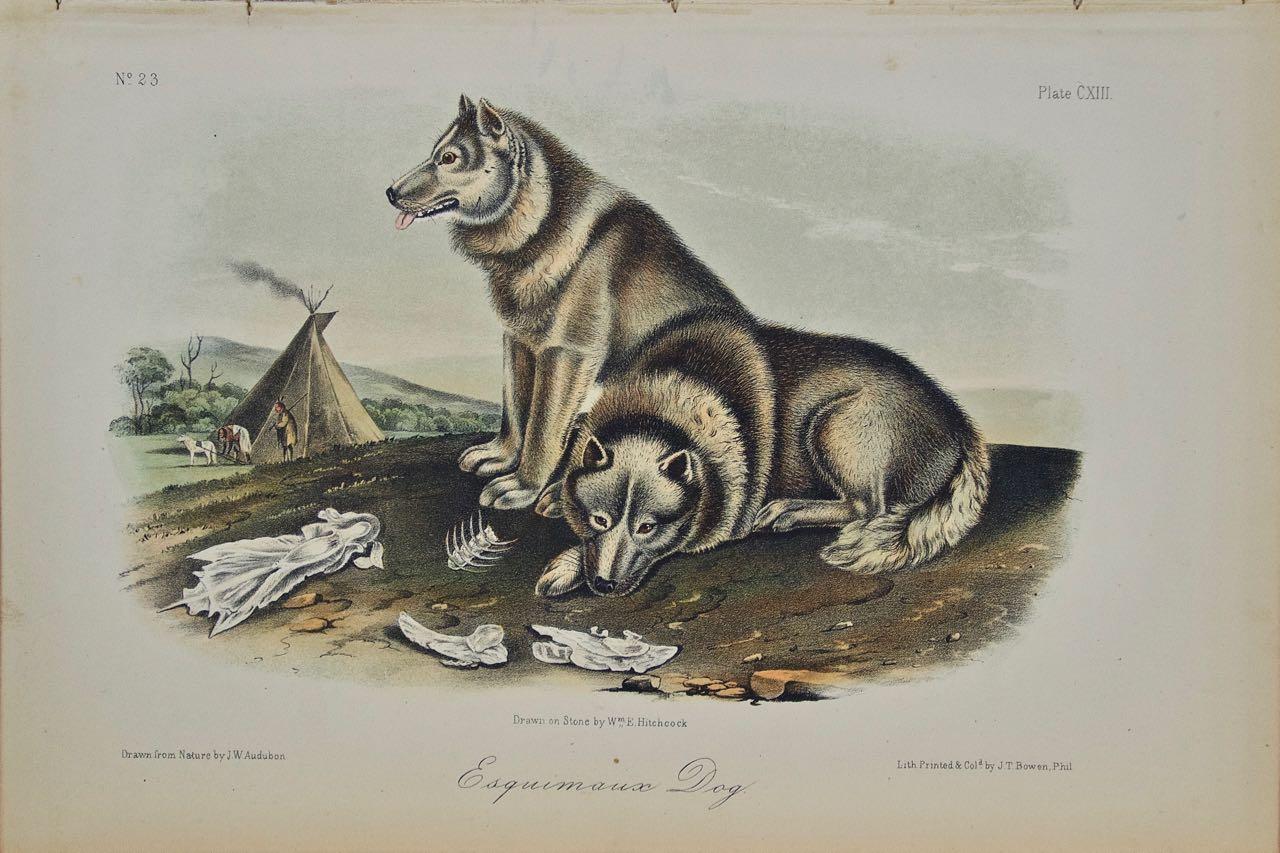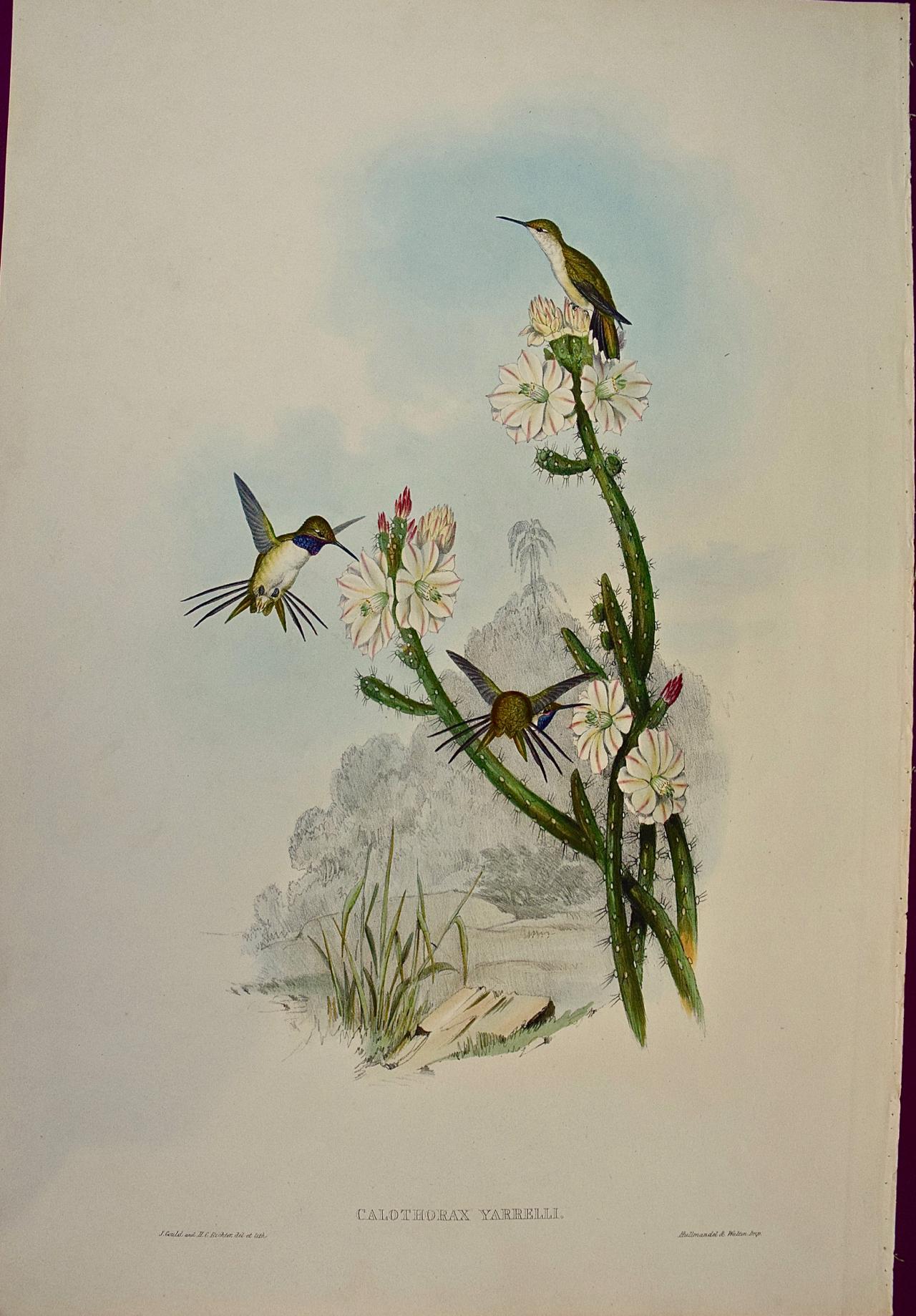Items Similar to Two Snowy Owls
Want more images or videos?
Request additional images or videos from the seller
1 of 5
Roger Tory PetersonTwo Snowy Owls
About the Item
Color Lithograph
Image Size: 30 x 19 inches
Framed Size: 40.25 x 29.75 inches
Edition 392/950
Artist Signed and Numbered
Artist and naturalist Roger Tory Peterson, initially famous for his 1934 field guide to the study of birds, was born of Swedish immigrant, working-class parents in 1908 in rural Jamestown, in upstate New York. As a boy, apparently imbued with a passion present from birth, he observed and sketched the abundant birds of wood and field. He also read about Audubon, Lear, Durer and Fuertes, artists who painted nature. His interest in birds was also guided by his seventh grade teacher, Blanche Hornbeck, who had started a Junior Audubon Club. Peterson has said, " I can't remember a time when I didn't watch birds"
Peterson later studied commercial art at the Art Students League and National Academy of Design in New York City. As a young man, after his schooling, he taught art and science in Massachusetts, where he created his unique system for identifying birds in the field. He later developed and published more than fifty other guides on subjects as diverse as mushrooms, clouds, fish, stars and insects.
One of the world's preeminent naturalists, Peterson's identification system for birds in their natural habitat was called the greatest invention since binoculars. He commented on the book, its methods and origins in 1980: "In 1934 there was nothing remotely like the Field Guide in print. Still, I can't take credit for inventing something out of whole cloth. My special contribution was the visual element within a carefully chosen context. Other ornithologists, both noted and nameless, had worked out the field marks of most birds. I combined their knowledge with my visual presentation and, at the urging of two friends in particular, carried the idea through. Their encouragement, my native interest in birds, and my professional training as an artist enabled me to create something that appeared new, though it was really a kind of fertile hybrid."
Peterson credits Ernest Thompson Seton's semi-autobiographical story, "Two Little Savages," with awakening him to the individuality in the markings of birds. Peterson says, "I don't remember when I first read that tale. As a boy I found my most faithful friends in books Somewhat solitary, I was fascinated by birds and that set me distinctly apart. In Jamestown, New York, and throughout the nation, bird watchers were rare. They were considered kooks, though we didn't have that word then (I was called a number of other things, names I'd rather leave unspoken)."
Peterson was twice nominated for a Nobel Prize, receiving every major award for ornithology, natural science, and conservation. He was awarded twenty-two honorary degrees, as well as numerous medals and citations, including the Presidential Medal of Freedom.
Peterson was also a worldwide filmmaker, making films in Europe, Africa, the Arctic, Galapagos Islands, Antarctica as well as at home in America. For more than thirty years, Peterson was art director for the National Wildlife Federation. He was a member of the board of directors of Defenders of Wildlife from 1965 to 1973. Peterson was also art editor of the National Audubon Society's magazine, as well as in charge of their educational programs.
Peterson's paintings are in the collections of the Metropolitan Museum of Art, New York City; Minneapolis Institute of Art; and the Leigh Yawkey Woodson Art Museum. They were exhibited at the Smithsonian Institution, Washington, D.C. and California Academy of Sciences.
Roger Tory Peterson died on July 28, 1996 at his home in Old Lyme, Connecticut. He was 87.
- Creator:Roger Tory Peterson (1908 - 1996, American)
- Dimensions:Height: 40.25 in (102.24 cm)Width: 29.75 in (75.57 cm)
- Medium:
- Movement & Style:
- Period:
- Condition:The lithograph is in excellent condition. The frame does have some scuff/scrapes to the left side. Please email or call if you would like to see more detailed images.
- Gallery Location:Missouri, MO
- Reference Number:1stDibs: LU74732249743
About the Seller
5.0
Vetted Seller
These experienced sellers undergo a comprehensive evaluation by our team of in-house experts.
Established in 1970
1stDibs seller since 2017
142 sales on 1stDibs
Typical response time: 21 hours
- ShippingRetrieving quote...Ships From: Missouri, MO
- Return PolicyA return for this item may be initiated within 2 days of delivery.
More From This SellerView All
- Nasiterna BruijniBy John GouldLocated in Missouri, MOJohn Gould (British, 1804-1881) Nasiterna Bruijni c. 1849-1861 Hand Colored Lithograph Image Size: approx 19.5 x 13.5 inches Framed Size: 27 3/8 x 21 1/2 inches John Gould was an English ornithologist and bird artist. The Gould League in Australia was named after him. His identification of the birds now nicknamed "Darwin's finches" played a role in the inception of Darwin's theory of evolution by natural selection. Gould's work is referenced in Charles Darwin's book, On the Origin of Species. Gould was born in Lyme Regis, Dorset, the son of a gardener, and the boy probably had a scanty education. Shortly afterwards his father obtained a position on an estate near Guildford, Surrey, and then in 1818 became foreman in the Royal Gardens of Windsor. He was for some time under the care of J T Aiton, of the Royal Gardens of Windsor. The young Gould started training as a gardener, being employed under his father at Windsor from 1818 to 1824, and he was subsequently a gardener at Ripley Castle in Yorkshire. He became an expert in the art of taxidermy, and in 1824 he set himself up in business in London as a taxidermist, and his skill led to him becoming the first Curator and Preserver at the museum of the Zoological Society of London in 1827. Gould's position brought him into contact with the country's leading naturalists, and also meant that he was often the first to see new collections of birds given to the Society. In 1830 a collection of birds arrived from the Himalayas, many not previously described. Gould published these birds in A Century of Birds from the Himalaya Mountains (1830-1832). The text was by Nicholas Aylward Vigors, and the illustrations were lithographed by Gould's wife Elizabeth, daughter of Nicholas Coxen of Kent. This work was followed by four more in the next seven years including Birds of Europe in five volumes - completed in 1837, with the text written by Gould himself, edited by his clerk Edwin Prince. Some of the illustrations were made by Edward Lear as part of his Illustrations of the Family of Psittacidae in 1832. Lear however was in financial difficulty, and he sold the entire set of lithographs to Gould. The books were published in a very large size, imperial folio, with magnificent coloured plates. Eventually 41 of these volumes were published with about 3000 plates. They appeared in parts at £3 3s. a number, subscribed for in advance, and in spite of the heavy expense of preparing the plates, Gould succeeded in making his ventures pay and in realizing a fortune. In 1838 he and his wife moved to Australia to work on the Birds of Australia and shortly after his return to England, his wife died in 1841. When Charles Darwin presented his mammal and bird specimens collected during the second voyage of HMS Beagle to the Geological Society of London at their meeting on 4 January 1837, the bird specimens were given to Gould for identification. He set aside his paying work and at the next meeting on 10 January reported that birds from the Galápagos Islands, which Darwin had thought were blackbirds, "gross-bills" and finches were in fact "a series of ground Finches which are so peculiar" as to form "an entirely new group, containing 12 species." This story made the newspapers. In March, Darwin met Gould again, learning that his Galápagos "wren" was another species of finch and the mockingbirds he had labeled by island were separate species rather than just varieties, with relatives on the South American mainland. Subsequently Gould advised that the smaller southern Rhea specimen that had been rescued from a Christmas dinner...Category
1850s Naturalistic Animal Prints
MaterialsLithograph
- Nasiterna PygmaeBy John GouldLocated in Missouri, MOJohn Gould (British, 1804-1881) Nasiterna Pygmae c. 1849-1861 Hand Colored Lithograph Image Size: approx 19.5 x 13.5 inches Framed Size: 27 3/8 x 21 1/2 inches John Gould was an English ornithologist and bird artist. The Gould League in Australia was named after him. His identification of the birds now nicknamed "Darwin's finches" played a role in the inception of Darwin's theory of evolution by natural selection. Gould's work is referenced in Charles Darwin's book, On the Origin of Species. Gould was born in Lyme Regis, Dorset, the son of a gardener, and the boy probably had a scanty education. Shortly afterwards his father obtained a position on an estate near Guildford, Surrey, and then in 1818 became foreman in the Royal Gardens of Windsor. He was for some time under the care of J T Aiton, of the Royal Gardens of Windsor. The young Gould started training as a gardener, being employed under his father at Windsor from 1818 to 1824, and he was subsequently a gardener at Ripley Castle in Yorkshire. He became an expert in the art of taxidermy, and in 1824 he set himself up in business in London as a taxidermist, and his skill led to him becoming the first Curator and Preserver at the museum of the Zoological Society of London in 1827. Gould's position brought him into contact with the country's leading naturalists, and also meant that he was often the first to see new collections of birds given to the Society. In 1830 a collection of birds arrived from the Himalayas, many not previously described. Gould published these birds in A Century of Birds from the Himalaya Mountains (1830-1832). The text was by Nicholas Aylward Vigors, and the illustrations were lithographed by Gould's wife Elizabeth, daughter of Nicholas Coxen of Kent. This work was followed by four more in the next seven years including Birds of Europe in five volumes - completed in 1837, with the text written by Gould himself, edited by his clerk Edwin Prince. Some of the illustrations were made by Edward Lear as part of his Illustrations of the Family of Psittacidae in 1832. Lear however was in financial difficulty, and he sold the entire set of lithographs to Gould. The books were published in a very large size, imperial folio, with magnificent coloured plates. Eventually 41 of these volumes were published with about 3000 plates. They appeared in parts at £3 3s. a number, subscribed for in advance, and in spite of the heavy expense of preparing the plates, Gould succeeded in making his ventures pay and in realizing a fortune. In 1838 he and his wife moved to Australia to work on the Birds of Australia and shortly after his return to England, his wife died in 1841. When Charles Darwin presented his mammal and bird specimens collected during the second voyage of HMS Beagle to the Geological Society of London at their meeting on 4 January 1837, the bird specimens were given to Gould for identification. He set aside his paying work and at the next meeting on 10 January reported that birds from the Galápagos Islands, which Darwin had thought were blackbirds, "gross-bills" and finches were in fact "a series of ground Finches which are so peculiar" as to form "an entirely new group, containing 12 species." This story made the newspapers. In March, Darwin met Gould again, learning that his Galápagos "wren" was another species of finch and the mockingbirds he had labeled by island were separate species rather than just varieties, with relatives on the South American mainland. Subsequently Gould advised that the smaller southern Rhea specimen that had been rescued from a Christmas dinner...Category
Mid-19th Century Naturalistic Animal Prints
MaterialsLithograph
- Bareback Act, Old HippodromeBy Gifford BealLocated in Missouri, MOBareback Act, Old Hippodrome By Gifford Beal (1879-1956) Signed Lower Right Unframed: 6.5" x 9.5" Framed: 17.5" x 20" Gifford Beal, painter, etcher, muralist, and teacher, was born in New York City in 1879. The son of landscape painter William Reynolds Beal, Gifford Beal began studying at William Merritt Chase's Shinnecock School of Art (the first established school of plein air painting in America) at the age of thirteen, when he accompanied his older brother, Reynolds, to summer classes. He remained a pupil of Chase's for ten years also studying with him in New York City at the artist's private studio in the Tenth Street Studio Building. Later at his father's behest, he attended Princeton University from 1896 to 1900 while still continuing his lessons with Chase. Upon graduation from Princeton he took classes at the Art Students' League, studying with impressionist landscape painter Henry Ward Ranger and Boston academic painter Frank Vincent DuMond. He ended up as President of the Art Students League for fourteen years, "a distinction unsurpassed by any other artist." His student days were spent entirely in this country. "Given the opportunity to visit Paris en route to England in 1908, he chose to avoid it" he stated, "I didn't trust myself with the delightful life in ParisIt all sounded so fascinating and easy and loose." His subjects were predominately American, and it has been said stylistically "his art is completely American." Gifford achieved early recognition in the New York Art World. He became an associate member of the National Academy of Design in 1908 and was elected to full status of academician in 1914. He was known for garden parties, circuses, landscapes, streets, coasts, flowers and marines. This diversity in subject matter created "no typical or characteristic style to his work." Beal's style was highly influenced by Chase and Childe Hassam, a long time friend of the Beal family who used to travel "about the countryside with Beal in a car sketching...Category
20th Century American Modern Animal Prints
MaterialsLithograph
- Le Christ a l'Horloge, ParisBy Marc ChagallLocated in Missouri, MOMarc Chagall "Le Christ a l'Horloge, Paris" (Christ in the Clock) 1957 (M. 196) Color Lithograph on Arches Wove Paper Signed in Pencil "Marc Chagall" Lower Right Initialed "H.C." (Hors Commerce) Lower Left, aside from numbered edition of 90 *Floated in Gold Frame with Linen Matting, UV Plexiglass Sheet Size: 18 3/4 x 14 3/4 inches (47.5 cm x 38 cm) Image Size: 9 3/4 x 8 1/2 inches Framed Size: 28.5 x 24.25 inches Marc Chagall was a man of keen intelligence, a shrewd observer of the contemporary scene, with a great sympathy for human suffering. He was born on July 7, 1887 in Vitebsk, Russia; his original name was Moishe Shagal (Segal), but when he became a foremost member of the Ecole de Paris, he adopted French citizenship and the French spelling of his name. Vitebsk was a good-sized Russian town of over 60,000, not a shtetl. His father supported a wife and eight children as a worker in a herring-pickling plant. Sheltered by the Jewish commandment against graven images, the young Chagall never saw so much as a drawing until, one day, he watched a schoolmate copying a magazine illustration. He was ridiculed for his astonishment, but he began copying and improvising from magazines. Both Chagall's parents reluctantly agreed to let him study with Yehuda Pen, a Jewish artist in Vitebsk. Later, in 1906, they allowed their son to study in St. Petersburg, where he was exposed to Russian Iconography and folk art. At that time, Jews could leave the Pale only for business and employment and were required to carry a permit. Chagall, who was in St. Petersburg without a permit, was imprisoned briefly. His first wife, Bella Rosenfeld, was a product of a rich cultivated and intellectual group of Jews in Vitebsk. Chagall was made commissar for the arts for the area, charged with directing its cultural life and establishing an art school. Russian folklore, peasant life and landscapes persisted in his work all his life. In 1910 a rich patron, a lawyer named Vinaver, staked him to a crucial trip to Paris, where young artists were revolutionizing art. He also sent him a handsome allowance of 125 francs (in those days about $24) each month. Chagall rejected cubism, fauvism and futurism, but remained in Paris. He found a studio near Montparnasse in a famous twelve-sided wooden structure divided into wedge-shaped rooms. Chaim Soutine, a fellow Russian Jew, and Modigliani lived on the same floor. To Chagall's astonishment, he found himself heralded as one of the fathers of surrealism. In 1923, a delegation of Max Ernst, Paul Eluard and Gala (later Salvador Dali's wife) actually knelt before Chagall, begging him to join their ranks. He refused. To understand Chagall's work, it is necessary to know that he was born a Hasidic Jew, heir to mysticism and a world of the spirit, steeped in Jewish lore and reared in the Yiddish language. The Hasidim had a special feeling for animals, which they tried not to overburden. In the mysterious world of Kabbala and fantastic ancient legends of Chagall's youth, the imaginary was as important as the real. His extraordinary use of color also grew out of his dream world; he did not use color realistically, but for emotional effect and to serve the needs of his design. Most of his favorite themes, though superficially light and trivial, mask dark and somber thoughts. The circus he views as a mirror of life; the crucifixion as a tragic theme, used as a parallel to the historic Jewish condition, but he is perhaps best known for the rapturous lovers he painted all his life. His love of music is a theme that runs through his paintings. After a brief period in Berlin, Chagall, Bella and their young daughter, Ida, moved to Paris and in 1937 they assumed French citizenship. When France fell, Chagall accepted an invitation from the Museum of Modern Art to immigrate to the United States. He was arrested and imprisoned in Marseilles for a short time, but was still able to immigrate with his family. The Nazi onslaught caught Chagall in Vichy, France, preoccupied with his work. He was loath to leave; his friend Varian Fry rescued him from a police roundup of Jews in Marseille, and packed him, his family and 3500 lbs. of his art works on board a transatlantic ship. The day before he arrived in New York City, June 23, 1941, the Nazis attacked Russia. The United States provided a wartime haven and a climate of liberty for Chagall. In America he spent the war years designing large backdrops for the Ballet. Bella died suddenly in the United States of a viral infection in September 1944 while summering in upstate New York. He rushed her to a hospital in the Adirondacks, where, hampered by his fragmentary English, they were turned away with the excuse that the hour was too late. The next day she died. He waited for three years after the war before returning to France. With him went a slender married English girl, Virginia Haggard MacNeil; Chagall fell in love with her and they had a son, David. After seven years she ran off with an indigent photographer. It was an immense blow to Chagall's ego, but soon after, he met Valentine Brodsky, a Russian divorcee designing millinery in London (he called her Fava). She cared for him during the days of his immense fame and glory. They returned to France, to a home and studio in rustic Vence. Chagall loved the country and every day walked through the orchards, terraces, etc. before he went to work. Chagall died on March 28, 1985 in the south of France. His heirs negotiated an arrangement with the French state allowing them to pay most of their inheritance taxes in works of art. The heirs owed about $30 million to the French government; roughly $23 million of that amount was deemed payable in artworks. Chagall's daughter, Ida and his widow approved the arrangement. Written and submitted by Jean Ershler Schatz, artist and researcher from Laguna Woods, California. Sources: Hannah Grad Goodman in Homage to Chagall in Hadassah Magazine, June 1985 Jack Kroll in Newsweek, April 8, 1985 Andrea Jolles in National Jewish Monthly Magazine, May 1985 Michael Gibson...Category
1950s Modern Figurative Prints
MaterialsLithograph
- Herring GullsBy Jamie WyethLocated in Missouri, MOJamie Wyeth "Herring Gulls" 1978 Color Lithograph Signed Lower Right Numbered Lower Left 149/300 Born in 1946, James Browning Wyeth came of age when the meaning of patriotism was clouded by the traumas of the Vietnam War and the scandals of Watergate. Working in an era of turmoil and questioning of governmental authority, he did art that encompassed both marching off to war and marching in protest. One of James's early masterworks, Draft Age (1965) depicts a childhood friend as a defiant Vietnam-era teenager resplendent in dark sunglasses and black leather jacket in a suitably insouciant pose. Two years later Wyeth painstakingly composed a haunting, posthumous Portrait of President John F. Kennedy (1967) that seems to catch the martyred Chief Executive in a moment of agonized indecision. As Wyeth Center curator Lauren Raye Smith points out, Wyeth "did not deify the slain president, [but] on the contrary made him seem almost too human." Based on hours of study and sketching of JFK's brothers Robert and Edward - documented by insightful studies in the exhibition - the final, pensive portrait seemed too realistic to family members and friends. "His brother Robert," writes Smith in the exhibition catalogue, "reportedly felt uneasy about this depiction, and said it reminded him of the President during the Bay of Pigs invasion." In spite of these misgivings, James's JFK likeness has been reproduced frequently and is one of the highlights of this show. The poignancy, appeal and perceptiveness of this portrait, painted when the youngest Wyeth was 21 years old, makes one wish he would do more portraits of important public figures. James himself feels he is at his best painting people he knows well, as exemplified by his vibrant Portrait of Jean Kennedy Smith (1972), which captures the vitality of the slain President's handsome sister. He did paint a portrait of Jimmy Carter for the January 1977 man-of-the-year cover of Time magazine, showing the casually dressed President-elect as a straightforward character posed under a flag-draped water tower next to the family peanut plant in Plains, Ga. James recalls that Carter had one Secret Service agent guarding him as he posed outdoors, a far cry from the protection our Chief Executives require today. As a participating artist in the "Eyewitness to Space" program organized by the National Aeronautics and Space Administration in collaboration with the National Gallery of Art in the late 1960s, Wyeth deftly recorded in a series of watercolors his eyewitness observations of dramatic spacecraft launchings and more mundane scenes associated with the space program. Commissioned by Harper's Magazine to cover the 1974 congressional hearings and trials of Watergate figures, James Wyeth executed a series of perceptive and now evocative sketches that recall those dark chapters in our history. Memorable images include a scowling John Ehrlichman, a hollow-eyed Bob Haldeman, an owlish Charles Colson, a focused Congressman Peter Rodino, a grim visaged Father/ Congressman Robert Drinan, and vignettes of the press and various courtroom activities. An 11-by-14-inch pencil sketch of the unflappable Judge John Sirica is especially well done. These "images are powerful as historical records," observes Smith, "and as lyrically journalistic impressions of events that changed the nation forever." Wyeth's sketch of early-morning crowds lined up outside the Supreme Court building hoping to hear the Watergate case, with the ubiquitous TV cameramen looking on, is reminiscent of recent scenes as the high court grappled with the Bush-Gore contest. The Wyeth family penchant for whimsy and enigmatic images is evident in Islanders (1990), showing two of James's friends, wearing goofy hats, sitting on the porch of a small Monhegan Island (Me.) cottage draped with a large American flag. Mixing the serious symbolism of Old Glory with the irreverent appearance of the two men, James has created a puzzling but interesting composition. Painting White House...Category
1970s American Modern Animal Prints
MaterialsPaper, Lithograph
- One of Their Pets (Two Farm Boys and Cow at the Watering Hole)By Joseph VorstLocated in Missouri, MOOne of Their Pets (Two Farm Boys and Cow at The Watering Hole) By Joseph Vorst (1897-1947) Signed Lower Right Edition 1/50 Lower Left Unframed: 8.5" x 11" Framed: 16" x 18.5" German-born Joseph Vorst came from Essen (born June 19, 1897). His teacher was the leading German impressionist Max Liebermann (1847-1935), who was the champion of French impressionism in Berlin. He had traveled to Barbizon and Paris to see paintings by Manet first hand, including In the Conservatory, which made its way to Berlin. Later Vorst's home town of Essen would acquire a collection of modern art in 1921, which became the Museum Folkwang, one of the earliest of its kind. Most likely to escape the Nazis, Vorst made his way to Missouri; we know that he was a member of the American Artists Congress and he signed the famous "Call" in 1936 at the group's first congress, the left-wing organization that stood up to combat fascism. Surely he would have known Joe Jones...Category
Early 20th Century American Realist Landscape Prints
MaterialsLithograph
You May Also Like
- Lesser Moddy and Moddy Tern, antique sea bird chromolithograph print, 1889By Gracius BroinowskiLocated in Melbourne, Victoria'Lesser Moddy and Moddy Tern' Chromolithograph from Gracius Broinowski's 'The Birds of Australia' , 1887-1891. Gracius Joseph Broinowski (1837-191...Category
Late 19th Century Naturalistic Animal Prints
MaterialsLithograph
- A Family of Moorhens & Lilly Pad: A 19th C. Hand-colored Lithograph by GouldBy John Gould and Henry Constantine RichterLocated in Alamo, CAThis is an original 19th century hand-colored folio-sized lithograph entitled "Gallinula Chloropus" (Moorhen) by John Gould, published in his "Birds of Great Britain", published in London between 1862 and 1873. The print, which was drawn by Gould and Henry Richter and lithographed by Walter & Cohn, depicts a family of Moorhens, including two adults and six babies in a beautiful landscape. The adults are in the water and the babies are lying on the leaves a flowering lilly pad. This striking Gould hand-colored moorhen family lithograph is augmented with gum-arabic paint. The sheet measures 14.88" high and 21.75" wide. It is in excellent condition, other than a spot in the upper portion of the right margin and two small spots at the edge of the lower margin on the left. The original descriptive text pages from Gould's 19th century publication are included. There are several other unframed Gould hummingbird lithographs available on our 1stdibs and InCollect storefronts. Two or more of these striking lithographs would make an attractive display grouping. A discount is available for purchase of a set depending on the number. These additional Gould hummingbirds may be viewed by typing Timeless Intaglio...Category
Mid-19th Century Naturalistic Animal Prints
MaterialsLithograph
- Stow Wengenroth, Friendly Neighbors (Birds)By Stow WengenrothLocated in New York, NYEdition of 80. Signed and numbered in pencil. Really, no one could draw on a lithographic stone like Stow Wengenroth. He drew many animals and birds...Category
Mid-20th Century Naturalistic Landscape Prints
MaterialsLithograph
- Hummingbirds: 19th C. Gould Hand-colored "Cyanifrons", Blue-capped SaucerottiaBy John Gould and Henry Constantine RichterLocated in Alamo, CAThis is a hand-colored folio sized lithograph entitled "Saucerottia Cyanifrons", Blue-capped Saucerottia Hummingbirds by John Gould, published in his "A Monograph of the Trochilidae, or Family of Humming-birds", published in London in 1850. The print, which was drawn by Gould and Henry Richter and lithographed by Hullmandel and Walton, depicts two green, blue and a little brown colored hummingbirds about a plant with green leaves and pink flowers. This beautiful Gould hand-colored hummingbird lithograph has a few very small faint spots, but it is otherwise in excellent condition. The original text page is included. There are other unframed Gould hummingbird...Category
Mid-19th Century Naturalistic Animal Prints
MaterialsLithograph
- Yarrell's Wood-star Hummingbirds: A 19th Century Hand-Colored Gould LithographBy John Gould and Henry Constantine RichterLocated in Alamo, CAThis is a hand-colored folio sized lithograph entitled "Calothorax Yarrelli", Yarrell's Wood-star Hummingbirds by John Gould, published in his "A Monograph of the Trochilidae, or Family of Humming-birds", published in London in 1850. The print, which was drawn by Gould and Henry Richter and lithographed by Hullmandel and Walton, depicts three green, white, grey, and a little blue colored hummingbirds amid green cactus plants with white and pink colored flowers. The hummingbirds are augmented by gum-arabic paint, which gives them an iridescent appearance in areas in which it is used. This beautiful Gould hand-colored hummingbird lithograph is in excellent condition. The original descriptive text page from Gould's 19th century publication is included. There are several other unframed Gould hummingbird...Category
Mid-19th Century Naturalistic Animal Prints
MaterialsLithograph
- "Esquimaux Dog": An Original 19th C. Audubon Hand-colored Quadruped LithographBy John James AudubonLocated in Alamo, CAThis is an original John James Audubon hand-colored royal octavo lithograph entitled "Esquimaux Dog", No. 23, Plate CXIII, from Audubon's "Quadrupeds of North America". It was drawn ...Category
Mid-19th Century Naturalistic Animal Prints
MaterialsLithograph

